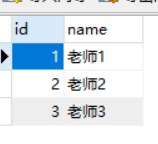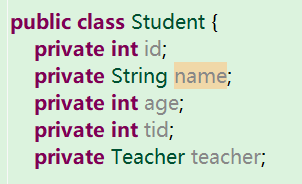MyBatis中实现多表查询
如果查询的数据量大,推荐使用N+1次查询。数据量少使用联合查询。。。
一、
1、Mybatis是实现多表查询方式
1.1 业务装配:对两个表编写单表查询语句,在业务(Service)把查询的两表结果合并
1.2 使用Auto Mapping 特性,在实现两表联合查询时通过别名完成映射
1.3 使用MyBatis<resultMap>属性进行实现
2、多表查询时,类中包含另一个类的对象的分类
2.1 单个对象
2.2 集合对象
二、resultMap属性
1、<resultMap>标签写在mapper.xml中,由程序员控制SQL查询结果与实体类的映射关系。
1.2 默认MyBatis使用Auto Mapping特性
2、使用<resultMap> 标签时,<select>标签不写resultType属性,而是使用resultMap属性 引用<resultMap>标签
3、使用resultMap实现单表映射关系
3.1 数据库设计

3.2 实体类设计

3.3 xxxmapper.xml代码
<mapper namespace="com.bjsxt.mapper.TeacherMapper">
<resultMap type="Teacher" id="mymap">
<!-- 主键使用id标签配置映射关系-->
<id column="id" property="id1"/>
<!-- 其他列使用result标签配置映射关系 -->
<result column="name" property="name1"/>
</resultMap>
<select id="selall" resultMap="mymap">
select * from teacher
</select>
</mapper>
三、使用resultMap 实现关联单个对象(N+1方式)
4.1 N+1 查询方式,先查询出某个表的全部信息,根据这个表的信息查询另一个表的信息
4.2 与业务装配的区别:
4.2.1 之前在service里面写代码,现在由mybatis完成装配
4.3 实现步骤:
4.3.1 在Student 实现类中包含了一个Teacher 对象

4.3.2 在TeacherMapper 中提供一个查询
<mapper namespace="com.bjsxt.mapper.TeacherMapper">
<select id="selById" resultType="teacher" parameterType="int" >
select * from teacher where id=#{0}
</select>
</mapper>
4.3.3 在StudentMapper中
4.3.3.1 <association> 装配一个对象时使用(包含在student中的对象)
4.3.3.2 property 关联对象
4.3.3.3 select 通过哪个查询查询出这个对象的信息
4.3.3.4 column 把当前表的哪个列的值作为参数传递给另一个查询
4.3.3.5 大前提使用N+1方式时,如果列名和属性名相同可以不配置,使用Auto mapping特性,但是mybatis默认只会给列专配一次。。
<mapper namespace="com.bjsxt.mapper.StudentMapper">
<resultMap type="student" id="stumap">
<id property="id" column="id"/>
<result property="name" column="name"/>
<result property="age" column="age"/>
<result property="tid" column="tid"/>
<!-- 如果关联一个对象 -->
<association property="teacher" select="com.bjsxt.mapper.TeacherMapper.selById" column="tid"></association>
</resultMap>
<select id="selall" resultMap="stumap">
select * from student
</select>
</mapper>
4.3.3.6 可以把代码简化
<mapper namespace="com.bjsxt.mapper.StudentMapper">
<resultMap type="student" id="stumap">
<result property="tid" column="tid"/>
<!-- 如果关联一个对象 -->
<association property="teacher" select="com.bjsxt.mapper.TeacherMapper.selById" column="tid"></association> </resultMap>
<select id="selall" resultMap="stumap">
select * from student
</select>
</mapper>
四、使用<resultMap>查询关联集合对象(N+1)
1、在Teacher 中添加List<Student>

2、 在StudentMapper.xml中添加通过tid查询
<mapper namespace="com.bjsxt.mapper.StudentMapper">
<select id="selByTid" parameterType="int" resultType="student">
select * from student where tid=#{0}
</select>
</mapper>
3、 在TeacherMapper.xml 中添加查询全部
3.1、<collection/> 当属性是集合类型时使用的标签
<mapper namespace="com.bjsxt.mapper.TeacherMapper">
<resultMap type="teacher" id="mymap">
<id column="id" property="id"/>
<result column="name" property="name"/>
<collection property="list" ofType="student" select="com.bjsxt.mapper.StudentMapper.selByTid" column="id"></collection>
</resultMap>
<select id="selAll" resultMap="mymap">
select * from teacher
</select>
</mapper>
五、使用<resultMap> 实现加载集合数据(联合查询方式)
1、在teacherMapper.xml中添加
1.1 mybatis可以通过主键判断对象是否被加载过
不需要担心创建重复 teacher
<mapper namespace="com.bjsxt.mapper.TeacherMapper">
<resultMap type="teacher" id="mymap">
<id property="id" column="tid"/>
<result property="name" column="tname"/>
<collection property="list" ofType="student" >
<id property="id" column="sid"/>
<result property="name" column="sname"/>
<result property="age" column="age"/>
<result property="tid" column="tid"/>
</collection>
</resultMap>
<select id="selAll" resultMap="mymap">
select t.id tid,t.name tname,s.id sid,s.name sname,age,tid from teacher t left join student s on t.id=s.tid
</select>
</mapper>
六、 使用 Auto Mapping结合别名实现多表查询
6.1 只能使用多表联合查询方式
6.2 要求:查询出的列和属性名相同
6.3 实现方式
6.3.1 . 在SQL是关键字符,两侧添加返单引号
<mapper namespace="com.bjsxt.mapper.StudentMapper">
<select id="selAll" resultType="student">
select t.id `teacher.id`,t.name `teacher.name`,s.id id,s.name name,age,tid
from student s left join teacher t on s.tid=t.id;
</select>
</mapper>
注意点:::使用Auto Mapping 特性查询集合不好用 !!!!
七、 使用注解查询
1、注解:为了简化配置文件
2、Mybatis 的注解简化 xxxmapper.xml文件
2.1 如果涉及动态SQL 依然使用 xxxmapper.xml
3、xxxmapper.xml 和注解可以共存
4、使用注解时 Mybatis.xml 中<mappers> 使用
4.1 <package/>
4.2 <mapper class=" "/>
5、实现查询
@Select("select * from teacher")
List<Teacher> selAll();
6、实现插入
@Insert("insert into teacher values(default,#{name})")
int inTeacher(Teacher teacher);
7、实现修改
@Update("update teacher set name=#{name} where id=#{id}")
int upTeacher(Teacher teacher);
8、实现删除
@Delete("delete from teacher where id=#{0}")
int delTeacher(int id);
9、使用注解实现 <resultMap> 功能
9.1、以 N+1 举例
9.2、在StudentMapper 接口添加查询
@Select ("select * from student where tid=#{0}")
List<Student> selByTid(int tid);
9.3、在TeacherMapper 接口添加
9.3.1 @Results() 相当于 <resultMap>
9.3.2 @Result() 相当于<id/> 或 <result/>
9.3.2.1 @Result(id=true) 相当于<id/>
9.3.3 @Many() 相当于<collection/>
9.3.4 @One() 相当于<association/>
@Results(value={
@Result(id=true,property="id",column="id"),
@Result(property="name",column="name"),
@Result(property="list",column="id",many=@Many(select="com.bjsxt.mapper.StudentMapper.selByTid" ))
})
@Select("select * from teacher")
List<Teacher> selTeacher();
MyBatis中实现多表查询的更多相关文章
- 在Mybatis中使用连表查询的一次实际应用
以前在工作中很少使用多表关联查询,对连表查询的具体作用和使用场景也没有很直观的认识,通过这次在项目中的实际应用,对此有了一定的认识,特记录如下. 关联表介绍: 分别是属性表attr_info.属性值表 ...
- Mybatis中的多表查询 多对多
示例:用户和角色 一个用户可以有多个角色 一个角色可以赋予多个用户 步骤: 1.建立两张表:用户表,角色表 让用户表和角色表具有多对多的关系. 需要使用中间表,中间表中包含各自的主键,在中间表中是外键 ...
- Mybatis中的多表查询 多对一,一对多
示例:用户和账户 一个用户可以有多个账户 一个账户只能属于一个用户(多个账户也可以属于同一个用户) 步骤: 1.建立两张表:用户表,账户表 让用户表和账户表之间具备一对多的关系:需要使用外键在账户表中 ...
- Hibernate中的多表查询及抓取策略
1.Hibernate中的多表查询 1.1SQL中的多表查询 [交叉连接] select * from A,B; [内连接] 显示内连接:inner join(inner 可以省略) Select * ...
- mysql中的回表查询与索引覆盖
了解一下MySQL中的回表查询与索引覆盖. 回表查询 要说回表查询,先要从InnoDB的索引实现说起.InnoDB有两大类索引,一类是聚集索引(Clustered Index),一类是普通索引(Sec ...
- Mybatis学习——一对一关联表查询
1.SQL语句建表 CREATE TABLE teacher( t_id ) ); CREATE TABLE class( c_id ), teacher_id INT ); ALTER TABLE ...
- MyBatis总结-实现关联表查询
一.一对一关联 1.1.提出需求 根据班级id查询班级信息(带老师的信息) 1.2.创建表和数据 创建一张教师表和班级表,这里我们假设一个老师只负责教一个班,那么老师和班级之间的关系就是一种一对一的关 ...
- MyBatis学习之多表查询
一对多需求:即一张表class中又含有多张表(teacher,student)内容.现根据class_id 来获取对应的班级信息(包括学生和老师信息) 方式一:嵌套结果 使用嵌套结果映射来处理重复的联 ...
- Oracle中的多表查询
多表查询 l 笛卡尔积: N*M l 使用关联字段消除笛卡尔积的多余数据: SELECT EMP.*,DEPT.DNAME,DEPT.LOC FROM EMP, DEPT WHERE EMP.DEPT ...
随机推荐
- Centos7在虚拟机中扩展磁盘空间
说明 情况:已经在VirtualBox虚拟机创建了一个磁盘并已经装好了系统,发现磁盘空间太小,需要再添加一个磁盘的大小.或者说Centos7系统需要扩展磁盘空间. 步骤 1.VirtualBox新建磁 ...
- 【资料整理】ADO.NET
ADO.NET: 1.SYSTEM.DATA 命名空间下类的集合的统称,用于操作 连接数据库的 它提供了统一的编程接口,可以操作不同的数据库 数据库实例:默认实例(MSSQLSEVER)和命名实例(M ...
- f5 Syslog管理
1.本地log保存7天.可输出至syslog服务器 local traffic 对应ltm
- mybatis批量更新update-设置多个字段值 报错 You have an error in your SQL syntax; check the manual that corresponds to your MySQL server version for the right syntax to use near
mybatis批量更新update-设置多个字段值 2016年08月01日 12:49:26 姚一号 阅读数:29539 标签: mysql mybatis批量更新批量更新allowMultiQuer ...
- java 线程Thread 技术--1.5 Executor Executors,ThreadPool,Queue
Executors : Executors ,就是一个线程工具类:大部分操作线程的方法,都可以在这个工具类中就行创建,执行,调用一些线程的方法: Executor : 用于执行和提交一个runnabl ...
- linux服务器搭建
centos7 java web项目环境搭配 2018年07月19日 17:20:21 阅读数:25 首先进行系统安装,此处不进行详细介绍,自行百度安装 一.配置ip地址信息 1.进入/etc/sys ...
- 2018.3.15 css课外小知识
1, 如果手动写动画, 最小的时间间隔是多久 为什么 多数显示器默认频率是60Hz 1s刷新60次 所以理论最小是1/60*1000ms=16.7ms 2. display:inline-bloc ...
- web 框架本质 及python三大框架对比
. 导入Bootstrap.css (开发版3.3.7) . 还要Bootstrap.js,并且还要引入jQuery(). . 栅格系统 . container,row必须包含在container中 ...
- 浏览器与服务器交互原理以及用java模拟浏览器操作v
浏览器应用服务器JavaPHPApache * 1,在HTTP的WEB应用中, 应用客户端和服务器之间的状态是通过Session来维持的, 而Session的本质就是Cookie, * 简单的讲,当浏 ...
- Phong和Blinn-Phong光照模型
Phong和Blinn-Phong是计算镜面反射光的两种光照模型,两者仅仅有很小的不同之处. 1.Phong模型 Phone模型计算中的一个关键步骤就是反射向量R的计算: 上图中的位于表面“下面”的向 ...
